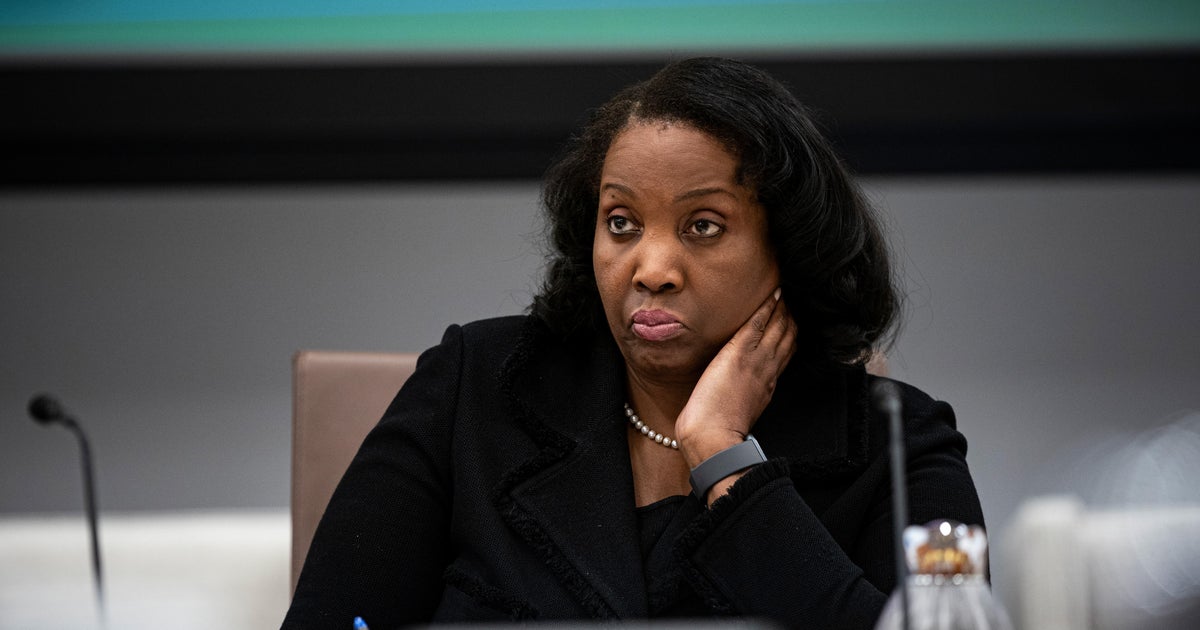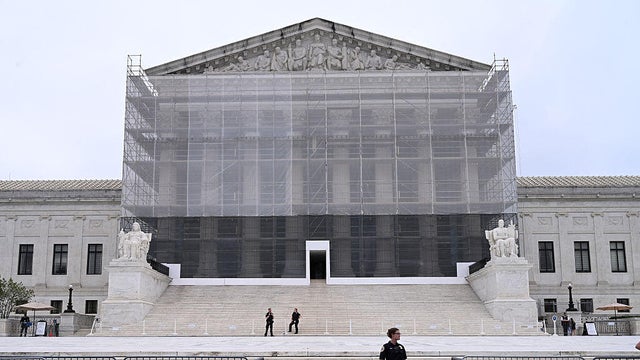

No response returned

Washington — President Trump's attempt to as a member of the Federal Reserve Bank's Board of Governors puts the nation in uncharted legal waters, and may ultimately be up to the Supreme Court to provide clarity on whether the move crosses a legal boundary, legal scholars expect.
Mr. Trump's move to oust Cook comes after months of griping about the Fed, which he says is moving too slowly to cut interest rates. But if her removal is allowed to stand — a question that will be decided by the courts — and the Senate confirms a replacement, it would mean of the seven-member Board of Governors.
Cook was named to the Fed Board by President Joe Biden in May 2022 and reappointed to serve a full 14-year term in September 2023, which is set to end in January 2038.
Mr. Trump said he was removing Cook from her post because of alleged mortgage fraud, though she has not been charged with any civil or criminal offense. The claims about Cook were made by Bill Pulte, the Trump-appointed director of the Federal Housing Finance Agency, who sent a to Attorney General Pam Bondi accusing Cook of taking out mortgages for properties in Michigan and Georgia in 2021 and claiming both would be used as her primary residence.
Pulte alleged that Cook was fraudulently attempting to gain more favorable lending terms. He has also against California Sen. Adam Schiff and New York Attorney General Letitia James, two Democrats who have been among the most prominent opponents of Mr. Trump. Both have denied the accusations.
In a statement released through the Fed last week, Cook said, "I do intend to take any questions about my financial history seriously as a member of the Federal Reserve and so I am gathering the accurate information to answer any legitimate questions and provide the facts."
Mr. Trump's move to fire Cook has set off a legal battle that could end with the Supreme Court, which has a 6-3 conservative majority. She Thursday challenging what the suit said is Mr. Trump's "unprecedented and illegal attempt to remove Governor Cook from her position which, if allowed to occur, would [be] the first of its kind in the Board's history."
"It is clear from the circumstances surrounding Governor Cook's purported removal from the Federal Reserve Board that the mortgage allegations against her are pretextual, in order to effectuate her prompt removal and vacate a seat for President Trump to fill and forward his agenda to undermine the independence of the Federal Reserve," her complaint, filed in federal district court in Washington, D.C., states.
The White House has defended Mr. Trump's move to terminate Cook from the Fed Board of Governors as within his lawful authority.
"The president determined there was cause to remove a governor who was credibly accused of lying in financial documents from a highly sensitive position overseeing financial institutions," White House spokesman Kush Desai said in a statement. "The removal of a governor for cause improves the Federal Reserve Board's accountability and credibility for both the markets and American people."
Mr. Trump's move to fire Cook is the latest in a string of removals of Democratic-appointed members of independent agencies, which have tested the bounds of his executive authority. He fired leaders of the and the Merit Systems Protection Board, ousted commissioners on the Consumer Product Safety Commission and sitting on the National Transportation Safety Board and Federal Labor Relations Authority.
Many of the firings have led to legal challenges. The officials removed from the boards have argued Mr. Trump violated federal laws that shield them from being removed at-will. Instead, Congress has said that the only grounds for their firings are inefficiency, neglect of duty or malfeasance in office. The laws were meant to insulate independent federal agencies and decisions from political pressure.
The law establishing the Federal Reserve System, known as the specifies that the president can only remove a member of its Board of Governors "for cause." But courts have said little about what may constitute "cause." While not defined in the Federal Reserve Act, Cook argues in her lawsuit that it means instances of inefficiency, neglect of duty, malfeasance in office or comparable misconduct.
The question of what qualifies as good cause, and whether Cook's alleged actions rise to it, are likely to be key questions to be answered during litigation, said Adam White, a senior fellow at the American Enterprise Institute who focuses on the Supreme Court.
"If [the justices] interpret good cause, they'll have to do so with an eye to the power and purpose of the Federal Reserve System more generally, the powers of the system and the purpose of its independence. What is 'good cause' with respect to the service of a Fed governor?" he said. "If all President Trump is going to go with is these allegations regarding the governor's mortgage application before she was on the board, I have a hard time believing that constitutes good cause because it's really not germane to the duties of the governor while she was in office."
In a series of recent decisions, the Supreme Court has reasserted the president's power to remove executive officers without cause.
In 2020, the high court ruled that the structure of the Consumer Financial Protection Bureau — headed by a single leader removable only for inefficiency, neglect or malfeasance — was unconstitutional.
Then, in a striking down the structure of the Federal Housing Finance Authority, the high court acknowledged that a "for cause" restriction in the 2008 Recovery Act "appears to give the president more removal authority than other removal provisions," like those restricting removals to instances of inefficiency, neglect of duty or malfeasance in office. Still, it said that "the Constitution prohibits even 'modest restrictions' on the President's power to remove the head of an agency with a single top officer."
This year, in response to emergency appeals brought by ousted officials from the NLRB and the MSPB, which are multi-member bodies, the Supreme Court while their legal challenges move forward, even though Congress shielded them from being removed at will. But in a brief decision in that case that appeared to be 6-3, the Supreme Court's majority singled out the Fed.
Two fired officials, Gwynne Wilcox and Cathy Harris, raised concerns about the consequences of allowing their removals and whether that would call into question the constitutionality of the Fed's for-cause removal protections. The court said it disagreed. Instead, it called the central bank a "uniquely structured, quasi-private entity that follows in the distinct historical tradition of the First and Second Banks of the United States," the 18th- and 19th-century central bank predecessors of the Fed.
Writing in dissent, Justice Elena Kagan said the majority created a "bespoke Federal Reserve exception," even though its independence "rests on the same constitutional and analytic foundations as that of the NLRB, MSPB, FTC, FCC, and so on."
"The court in that language does not resolve the question. All the court is saying is that the Federal Reserve is different from the FTC or from the NLRB," Joel Alicea, a law professor at the Catholic University of America, said. "Yeah, it is different, but is it sufficiently different to mean that it's not subject to the same rule? The court doesn't say."
While Mr. Trump has sought to exert new levels of control over the executive branch, the Supreme Court has to the removal powers, allowing Congress to protect certain officials from being fired without cause.
In a 1935 decision in the case Humphrey's Executor v. United States, the court found that Congress can restrict the president's authority to remove multi-member commissions of experts who are balanced along partisan lines and do not exercise any executive power.
In its decision allowing the firings of the labor board members, the Supreme Court's majority said the Justice Department "is likely to show that both the NLRB and MSPB exercise considerable executive power."
But White said the Fed is different from those agencies because of the authority it exerts.
"Under the last 15 years of precedents, the question is what kind of powers does the agency wield and are they substantially executive?" he said. "And for the Fed, it does have regulatory powers and it's possible they verge on something like executive power, but the overwhelming majority of what the Fed does that is of consequence is its monetary powers. That's why the court recognized that the Fed is different."
White continued: "The whole reason why we're sensitive about the president's attacks on the Fed versus the NLRB is that the Fed's overwhelming purpose and its most significant power are all something very different than simple law enforcement policy. Those powers, going back to the very beginning of the country, have never been treated as executive powers."
Alicea, however, disagreed. The Board of Governors has broad oversight and regulatory authority over the nation's banking system, he said.
"Those are core executive powers," he said.





